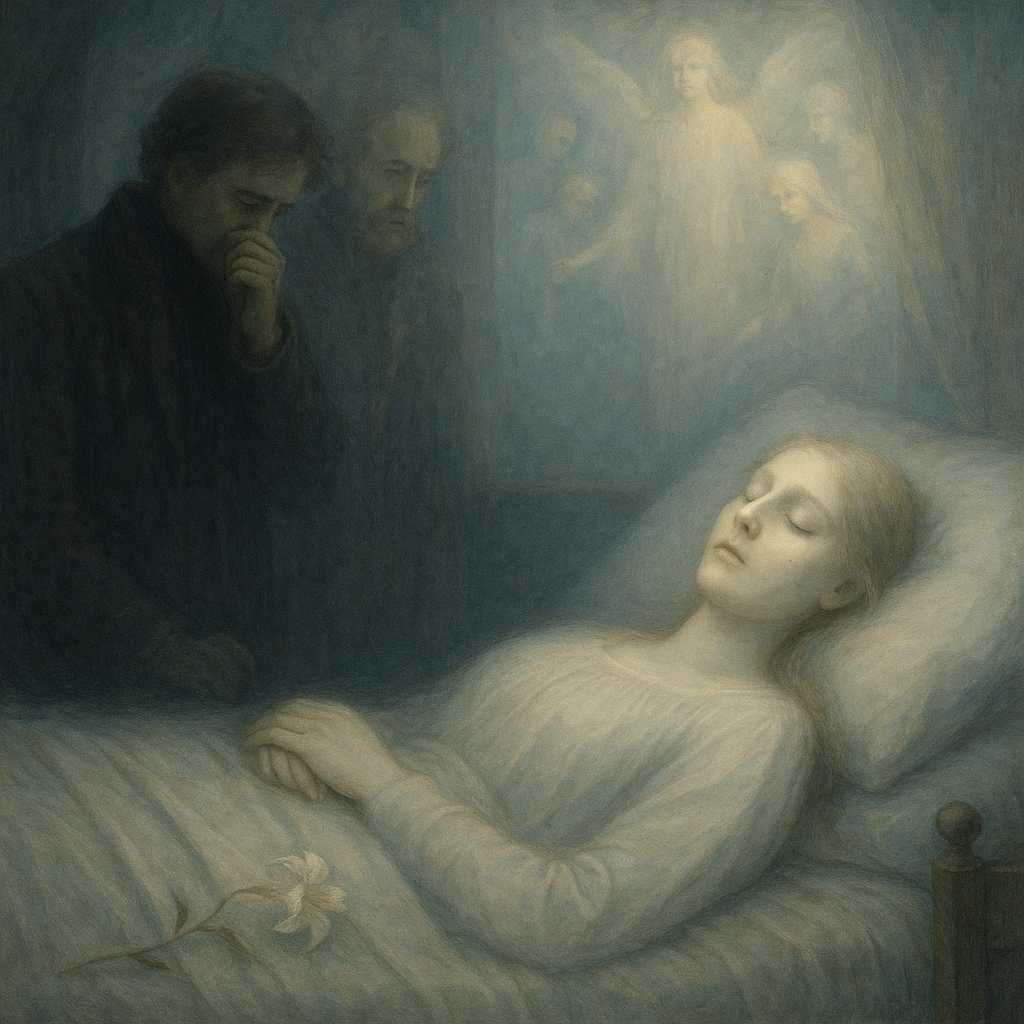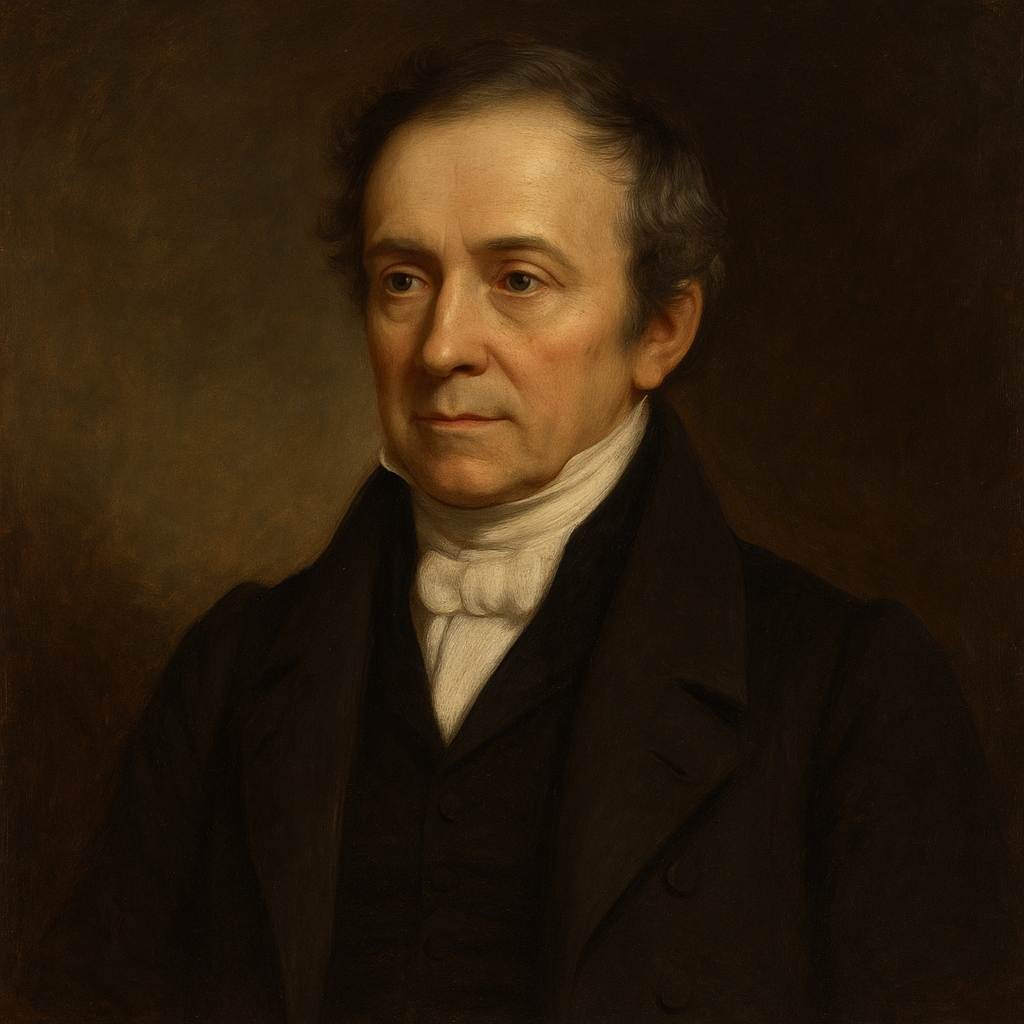Peace! what do tears avail?
Barry Cornwall
1787 to 1874

Peace! what do tears avail?
She lies all dumb and pale,
And from her eye
The spirit of lovely life is fading,
And she must die!
Why looks the lover wroth? the friend upbraiding?
Reply, reply!
Hath she not dwelt too long
’Midst pain, and grief, and wrong?
Then, why not die?
Why suffer again her doom of sorrow,
And hopeless lie?
Why nurse the trembling dream until to-morrow?
Reply, reply!
Death! Take her to thine arms,
In all her stainless charms,
And with her fly
To heavenly haunts, where, clad in brightness,
The Angels lie.
Wilt bear her there, O Death! in all her whiteness?
Reply, reply!
Barry Cornwall's Peace! what do tears avail?
Barry Cornwall (the pen name of Bryan Waller Procter) was a 19th-century English poet whose works often explored themes of mortality, love, and transcendence. His poem "Peace! what do tears avail?" is a poignant meditation on death, suffering, and the paradoxical longing for release from earthly pain. Through its lyrical intensity and emotional depth, the poem grapples with the inevitability of death while framing it as a merciful escape rather than a tragic end. This essay will examine the poem’s historical and cultural context, its use of literary devices, its central themes, and its emotional impact, while also considering philosophical and comparative perspectives.
Historical and Cultural Context
To fully appreciate "Peace! what do tears avail?", one must situate it within the Romantic and early Victorian periods, when poets frequently engaged with themes of death, melancholy, and spiritual transcendence. The early 19th century was marked by a fascination with the sublime—experiences of awe and terror in the face of nature, mortality, and the divine. Cornwall’s poem aligns with this tradition, particularly in its depiction of death as a sublime transition rather than a mere cessation of life.
Additionally, the poem reflects the era’s shifting attitudes toward death. The Victorian period, in particular, was characterized by elaborate mourning rituals and a heightened sentimentalization of death, partly due to high mortality rates from disease and childbirth. Cornwall’s speaker does not mourn conventionally; instead, they challenge the futility of tears and advocate for death as a release, a perspective that resonates with both Romantic idealism and Christian consolation literature.
Literary Devices and Structure
Cornwall employs several literary devices to heighten the emotional and philosophical weight of the poem.
1. Apostrophe and Rhetorical Questions
The poem opens with an imperative—"Peace! what do tears avail?"—immediately silencing conventional grief. The speaker then addresses abstract forces (Death) and unnamed figures (the lover, the friend), using rhetorical questions to underscore the futility of resistance:
"Why looks the lover wroth? the friend upbraiding? / Reply, reply!"
These questions are not meant to be answered by the reader but serve to emphasize the inevitability of the woman’s death and the irrationality of clinging to suffering.
2. Imagery of Transition and Transcendence
Cornwall contrasts earthly suffering with celestial peace through vivid imagery. The dying woman is "dumb and pale," her life fading, while Death is invited to take her "In all her stainless charms" to "heavenly haunts, where, clad in brightness, / The Angels lie." This dichotomy reinforces the Romantic idealization of death as a passage to a purer state of being.
3. Repetition and Urgency
The refrain "Reply, reply!" creates a rhythmic urgency, as if the speaker is demanding justification from those who resist death’s inevitability. This repetition also mirrors the cyclical nature of grief, where questions of "why?" persist without resolution.
4. Paradox and Consolation
The poem’s central paradox is that death, often feared, is framed as a benevolent force. The speaker does not deny the woman’s suffering but insists that death is preferable to "doom of sorrow." This aligns with Christian consolation poetry, where death is a gateway to eternal peace, yet Cornwall’s tone is more urgent, almost defiant, in its plea for release.
Themes
1. The Futility of Earthly Suffering
The poem challenges the notion that prolonged life is inherently desirable. The speaker questions why the dying woman should endure further pain:
"Hath she not dwelt too long / ’Midst pain, and grief, and wrong? / Then, why not die?"
This echoes philosophical debates about the ethics of suffering, reminiscent of Stoic and even early existentialist thought—suggesting that death may be a rational choice when life offers only torment.
2. Death as a Merciful Release
Unlike conventional elegies that lament death, Cornwall’s poem presents it as a deliverance. Death is personified not as a grim reaper but as a gentle escort to "heavenly haunts." This reflects the Romantic tendency to aestheticize mortality, seen also in Keats’ "Ode to a Nightingale" or Shelley’s "Adonais," where death is a transcendence rather than an end.
3. The Conflict Between Love and Reason
The "lover wroth" and the "friend upbraiding" represent emotional resistance to death, while the speaker adopts a more detached, almost rationalist perspective. This tension between grief and acceptance is central to the poem’s emotional complexity.
Emotional Impact
The poem’s power lies in its oscillation between despair and consolation. The opening lines evoke helplessness ("She lies all dumb and pale"), but the later stanzas transform this helplessness into a plea for mercy. The emotional arc moves from sorrow to something resembling hope—not for recovery, but for peace beyond suffering.
This duality makes the poem particularly resonant for readers who have witnessed prolonged suffering. It does not dismiss grief but reframes it, asking whether love sometimes selfishly clings to life at the expense of the sufferer’s peace.
Comparative and Philosophical Perspectives
Cornwall’s poem can be compared to other Romantic meditations on death. In Keats’ "When I Have Fears That I May Cease to Be," the poet grapples with mortality as a thief of potential, whereas Cornwall presents death as a liberator. Similarly, Emily Dickinson’s "Because I could not stop for Death" personifies death as a courteous suitor, much like Cornwall’s depiction of Death bearing the woman "in all her whiteness."
From a philosophical standpoint, the poem engages with theodicy—the question of why a benevolent God permits suffering. The speaker does not blame divinity but instead frames death as a divine mercy, a perspective that aligns with certain strands of Christian mysticism.
Conclusion
"Peace! what do tears avail?" is a masterful exploration of death’s dual nature—both as a source of grief and a release from pain. Through its urgent rhetorical questions, vivid imagery, and paradoxical consolation, Cornwall crafts a poem that is as much a philosophical argument as it is an elegy. Situated within the Romantic tradition, the work resonates with timeless questions about suffering, mortality, and the possibility of transcendence. Its emotional power lies in its refusal to offer easy comfort, instead demanding that the reader confront the harsh necessity of letting go.
In an age where death was both sanitized and sentimentalized, Cornwall’s poem stands out for its raw honesty and its almost defiant plea for peace. It remains a poignant reminder that sometimes, the most profound act of love is not to cling, but to release.
This text was generated by AI and is for reference only. Learn more
Want to join the discussion? Reopen or create a unique username to comment. No personal details required!



Comments
No comments yet. Be the first to comment!